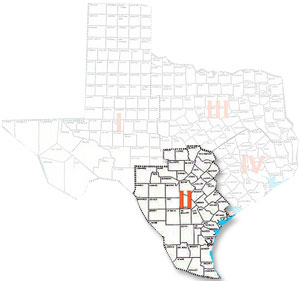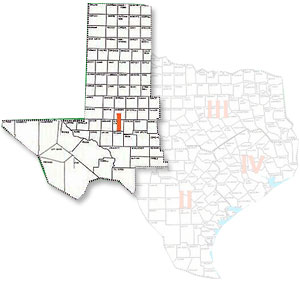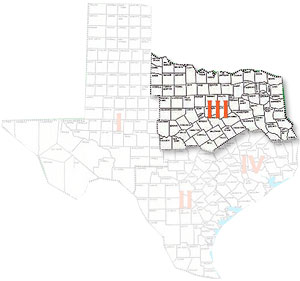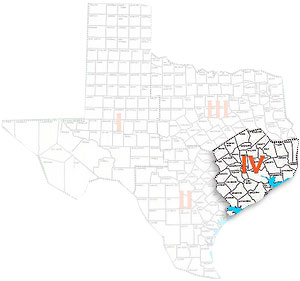AIPG District II – South Texas
District II Representative – Texas Section AIPG
This page represents the activities of the American Institute of Professional Geologists in the South District II of Texas. This District is geologically complex and contains abundant oil and gas resources, lignite, uranium and other natural resources. Such resources have allowed Texas to develop a diversified range of high-technology driven petrochemical and related industries as well as a sound agricultural base, both with environmental awareness and effective regulation.
Oil & Gas Exploration & Development
District II covers the southern part of Texas, and includes reserves in Cretaceous chalk, sandstones, and limestones as well as in Eocene sandstones. More than eight fields has been identified to date.
Lignite Resources
The two lignite belts present in north-east Texas extend into south Texas. Two mine-mouth power plants operate in the area, and more mines are under development. Additional mines are under consideration.
Uranium Resources
Upper Eocene and Miocene fluvial sediments host Tertiary-age "roll-front" uranium deposits. Uranium mining (both open pit and in-situ mining) and yellow-cake production were initiated in the 1970's and have continued sporadically since then. The typical "roll-front" shown in the above photo of an open-pit uranium mine forms the basis of exploration methods.
Geothermal Resources
Geopressured geothermal resources were identified in the 1970's and attempts at development and commercialization were made with only limited success. This resource awaits development.
Other Texas Mineral Resources (here)
Environmental Issues:
Water Supplies
In a population of rapid growth, nearly full employment, and a free economy, Texas residents debate the age-old conflict between industrial development and the status quo, resource utilization and appropriate management, and associated environmental issues. But population growth and economic development, coupled with a climate in which surface-water resources are scarce, have imposed real and potential water-supply problems in many areas of Texas. In much of Texas, available surface storage capacity in existing reservoirs will barely be sufficient to meet water demands of continued industrialization and urban development, especially during critical droughts which are common occurrences over the long term.
Extensive development of the readily available ground water has progressed rapidly over the past 20 years but has resulted in several problems, some local in nature, while others are more widespread. Problems of water quality, both from natural and man-made causes (e.g. nitrates), are expected to affect the suitability for use of water from portions of Texas' aquifers in the future. Natural pollution, primarily sodium chloride, results from salt springs and salt flats within drainage areas of the basins. In some areas, this problem has been aggravated to some extent by oil and gas exploration and production activities. Mining has also been indicated as contributing to pollution. Balancing resources and local needs to maintain economic growth and development are the primary goals in Texas.
More than 50 percent of Texas in underlain by seven major aquifers and 16 minor aquifers. Because of industrial and urban development, long-term use of ground water is lowering water levels to the extent costs of production are increasing rapidly. Surface-water reservoirs are being developed in south Texas, and elsewhere, to offset the foreseeable problems of the future.
For additional information on the oil & gas and other resources and activities in South Texas, see the Web sites of the local professional societies (here).
Index to Superfund Sites by County
If a county does not appear on this list, it is because there is no state or federal Superfund site in that county. This index includes all sites – those where cleanup is complete as well as those for which cleanup or assessment is in progress (here).
References:
Search Results for "Texas" (New)
Older References of Interest:
Spearing, D., 1991, Roadside Geology of Texas, Mountain Press Publishing Company, Missoula, MT, 418 p.
Fisher, W. L., and W. E. Galloway, 1983, Potential for Additional Oil Recovery in Texas, Bureau of Economic Geology Geological Circular 83-2, pp.6-7.
Campbell, M. D., and K. T. Biddle, 1977, Chapter 1: Frontier Exploration-Uranium, in Geology Alternate Energy Resources in South-Central United States, Houston Geological Society, M. D. Campbell (ed), pp. 3-44. (PDF)
Darling, B. K., B. J. Hibbs, and J. M. Sharp, Jr., 2017, "Integration of Carbon-14 and Oxygen-18 as a Basis for Differentiating between Pleistocene and Post-Pleistocene Groundwater Ages along Flow Paths in Two West Texas Bolson Aquifers, " GSA, (PDF).
Dickinson, K. A., and J. S. Duval, 1977, Chapter 2: Trend Exploration-Uranium, in Geology Alternate Energy Resources in South-Central United States, Houston Geological Society, M. D. Campbell (ed), pp.45-66. (PDF)
Wielchowsky, C . C., et al., 1977, Chapter 6: Frontier Exploration-Lignite, in Geology Alternate Energy Resources in South-Central United States, Houston Geological Society, M. D. Campbell (ed), pp.125-159.
Bebout, D. G., 1977, Chapter 12: Trend Exploration-Geopressured Geothermal Energy, in Geology Alternate Energy Resources in South-Central United States, Houston Geological Society, M. D. Campbell (ed), pp. 251-273.
Kallus, M. F., 1977, Chapter 4: Environmental Considerations-Uranium, in Geology Alternate Energy Resources in South-Central United States, Houston Geological Society, M. D. Campbell (ed), pp. 83-109.
Hirsch, A. M., 1977, Chapter 9: Environmental Considerations-Lignite, in Geology Alternate Energy Resources in South-Central United States, Houston Geological Society, M. D. Campbell (ed), pp. 193-202.
Gustavson, T. C. and C. W. Kreitler, 1977, Chapter 14: Environmental Considerations-Geopressured Geothermal Energy, in Geology Alternate Energy Resources in South-Central United States, Houston Geological Society, M. D. Campbell (ed), pp. 297-336.
Evans, T. J., 1974, Bituminous Coal in Texas, Bureau of Economic Geology Handbook 4, 65 p.
Kaiser, W. R., et.al., 1980, Lignite Resources in Texas , Bureau of Economic Geology Report of Investigations No. 104, 52 p.
Jones, D. C., 1973, An Investigation of the Nitrate Problem in Runnels County, Texas, Texas Water Development Board, EPA-R2-73-267, June, pp.6-7.
Brown, L. F., et al., 1976, Environmental Geologic Atlas of Texas Coastal Zone- Corpus Christi Area, Bureau of Economic Geology, 123 p.
Bebout, D. G., et al., 1976, Geothermal Resources, Frio Formation, Upper Texas Gulf Coast,, Bureau of Economic Geology Geological Circular 76-3, 47 p.
Dorfman, M., and R. O. Kehle, 1974, Potential Geothermal Resources of Texas, Bureau of Economic Geology Geothermal Circular 74-4, 33 p.
Smith, G. E., et al., 1982, Regional Hydrodynamics and Hydrochemistry of the Uranium-Bearing Oakville Aquifer (Miocene) of South Texas, Bureau of Economic Geology Report of Investigations No. 124, 31 p.
Galloway, W. E., et al., 1982, Depositional Framework, Hydrostratigraphy, and Uranium Mineralization of the Oakville Sandstone (Miocene), Texas Coastal Plain, Bureau of Economic Geology Report of Investigations No. 113, 51 p.
Collins, E. W., et al., 1980, Quaternary Faulting in East Texas, Bureau of Economic Geology Geological Circular 80-1, 20 p.
Anon., 1984, Water for Texas: A Comprehensive Plan for the Future, November, Texas Dept. of Water Resources GP-4-1, 72 p.
Ashworth, J. B., and J. Hopkins, 1995, Aquifers of Texas, Texas Water Development Board Report 345, November, 69 p.
In The News
Sponsors of the AIPG-TX GEODAYZ Training Program
2022
2018



























